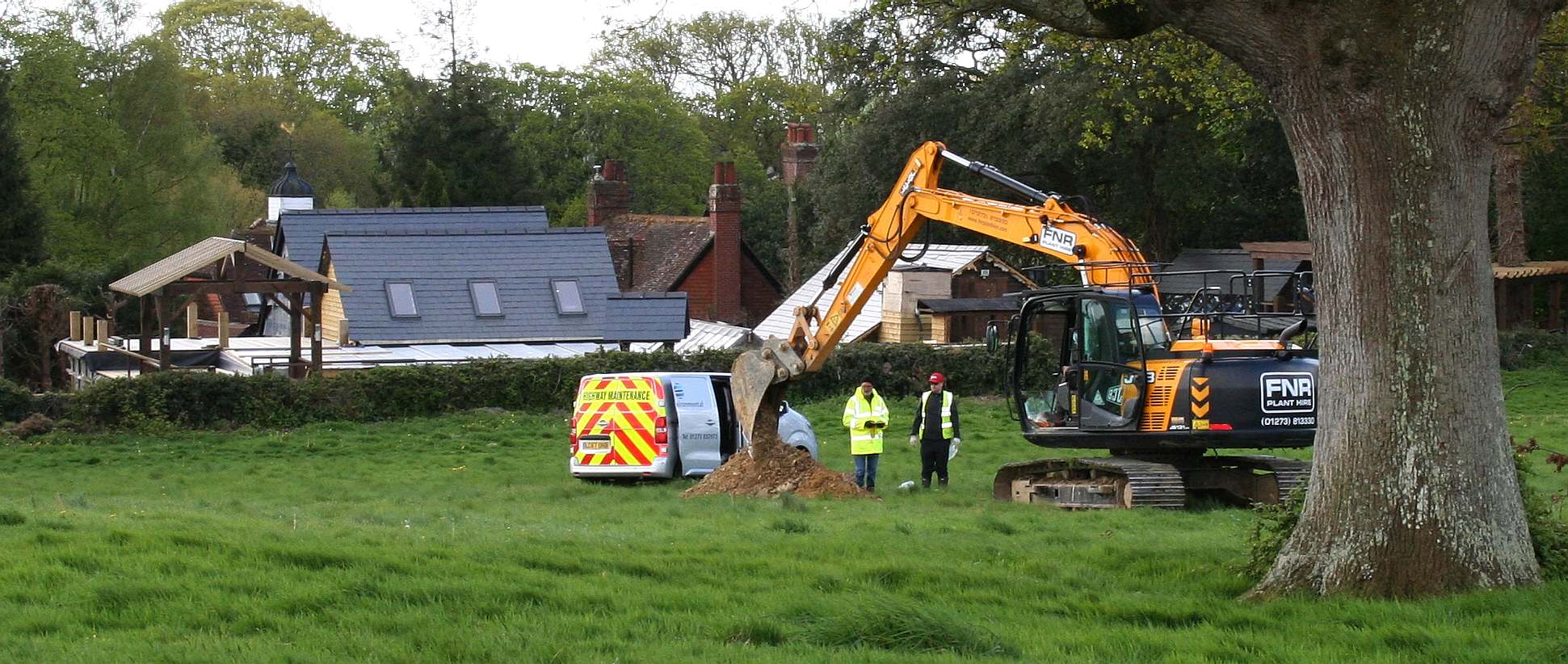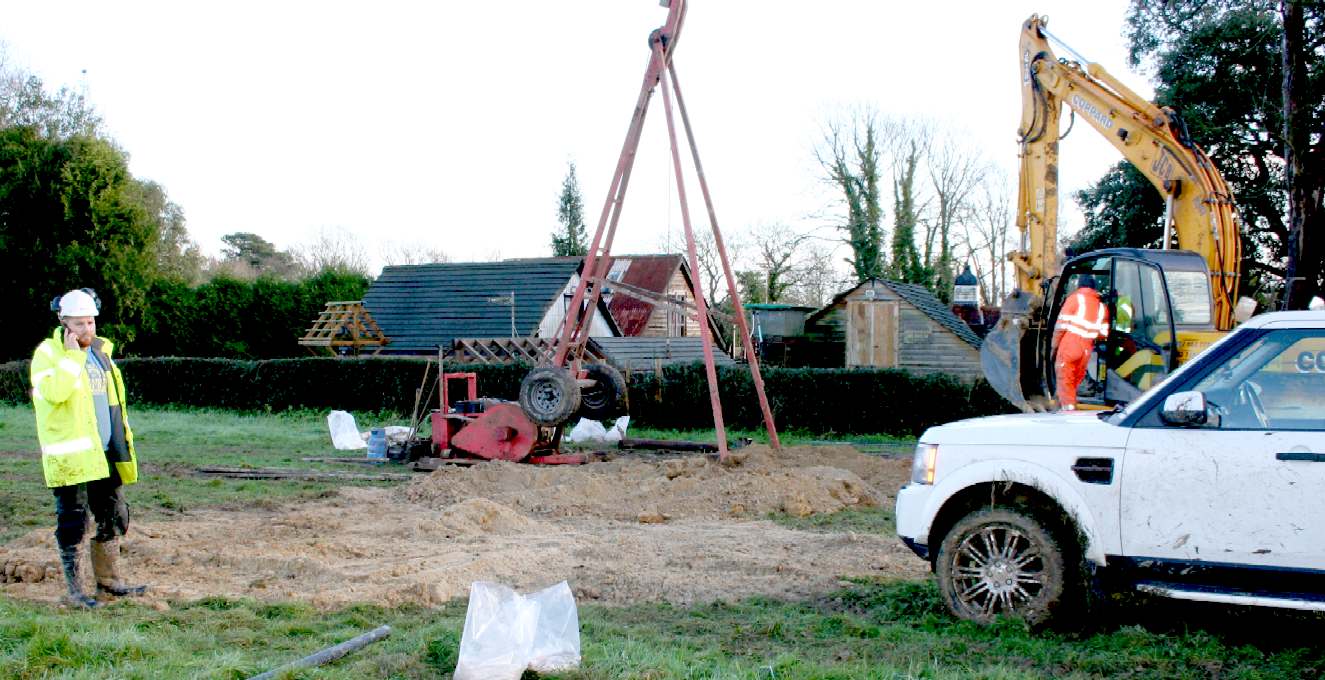|

WATER
RIGHTS - Clarion Housing Group and Thakeham
Homes are in danger of spoiling an ancient well that supplies water
to many concerns in this vicinity. In the picture you can see a hired
digger scooping out trenches to test drainage by pouring in water and
measuring the rate of absorption by the soil. It seems to us that if you
build houses on the ground that feeds the ancient well, that
contamination from garden treatments such as Roundup and engine oils,
etc., will find its way into this well leading to claims against the
owners of the houses who would have been sold a pup, and/or against the
Council for approving the proposal, by way of a negligence claim, and/or
against the vendors or developers. Any way you look at it the developers
and Council concerned should take steps to ensure that no development
takes place until the proper tests and evaluations have been completed,
and after that stage, to ensure that any houses built in this location
will not be on a path that includes the water
table that feeds the ancient well.
Any
failure to conduct the proper tests and house situation, along with safe
sewage disposal, may tempt the Secretary
of State to call in the application. We imagine that all of those
with a financial interest in this piece of greenbelt will want to
resolve issues before it starts to get complicated.
7.
REQUIRING GOOD DESIGN
56. The Government attaches great importance to the design of the built
environment. Good design is a key aspect of sustainable development, is indivisible from good planning, and should contribute positively to making
places better for people.
57. It is important to plan positively for the achievement of high quality and
inclusive design for all development, including individual buildings, public and
private spaces and wider area development schemes.
58. Local and neighbourhood plans should develop robust and comprehensive policies that set out the quality of development that will be expected for the
area. Such policies should be based on stated objectives for the future of the
area and an understanding and evaluation of its defining characteristics.
Planning policies and decisions should aim to ensure that developments:
●● will function well and add to the overall quality of the area, not just for the short term but over the lifetime of the development;
●● establish a strong sense of place, using streetscapes and buildings to
create attractive and comfortable places to live, work and visit;
●● optimise the potential of the site to accommodate development, create
and sustain an appropriate mix of uses (including incorporation of green
and other public space as part of developments) and support local facilities
and transport networks;
●● respond to local character and history, and reflect the identity of local
surroundings and materials, while not preventing or discouraging
appropriate innovation;
●● create safe and accessible environments where crime and disorder, and the
fear of crime, do not undermine quality of life or community cohesion;
and
●● are visually attractive as a result of good architecture and appropriate
landscaping.
59. Local planning authorities should consider using design codes where they
could help deliver high quality outcomes. However, design policies should
avoid unnecessary prescription or detail and should concentrate on guiding
the overall scale, density, massing, height, landscape, layout, materials and
access of new development in relation to neighbouring buildings and the
local area more generally.
60. Planning policies and decisions should not attempt to impose architectural
styles or particular tastes and they should not stifle innovation, originality or
initiative through unsubstantiated requirements to conform to certain
development forms or styles. It is, however, proper to seek to promote or
reinforce local distinctiveness.
61. Although visual appearance and the architecture of individual buildings are
very important factors, securing high quality and inclusive design goes
beyond aesthetic considerations. Therefore, planning policies and decisions
should address the connections between people and places and the
integration of new development into the natural, built and historic
environment.
62. Local planning authorities should have local design review arrangements in
place to provide assessment and support to ensure high standards of design.
They should also when appropriate refer major projects for a national design
review.13 In general, early engagement on design produces the greatest
benefits. In assessing applications, local planning authorities should have
regard to the recommendations from the design review panel.
63. In determining applications, great weight should be given to outstanding or
innovative designs which help raise the standard of design more generally in
the area.
64. Permission should be refused for development of poor design that fails to
take the opportunities available for improving the character and quality of an
area and the way it functions.
65. Local planning authorities should not refuse planning permission for buildings
or infrastructure which promote high levels of sustainability because of
concerns about incompatibility with an existing townscape, if those concerns
have been mitigated by good design (unless the concern relates to a
designated heritage asset and the impact would cause material harm to the
asset or its setting which is not outweighed by the proposalís economic,
social and environmental benefits).
66. Applicants will be expected to work closely with those directly affected by
their proposals to evolve designs that take account of the views of the
community. Proposals that can demonstrate this in developing the design
of the new development should be looked on more favourably.
67. Poorly placed advertisements can have a negative impact on the appearance
of the built and natural environment. Control over outdoor advertisements
should be efficient, effective and simple in concept and operation. Only those
advertisements which will clearly have an appreciable impact on a building or
on their surroundings should be subject to the local planning authorityís
detailed assessment. Advertisements should be subject to control only in the
interests of amenity and public safety, taking account of cumulative impacts.
68. Where an area justifies a degree of special protection on the grounds of
amenity, an Area of Special Control Order14 may be approved. Before
formally proposing an Area of Special Control, the local planning authority is
expected to consult local trade and amenity organisations about the
proposal. Before a direction to remove deemed planning consent is made for
specific advertisements, local planning authorities will be expected to
demonstrate that the direction would improve visual amenity and there is no
other way of effectively controlling the display of that particular class of
advertisement. The comments of organisations, and individuals, whose
interests would be affected by the direction should be sought as part of the
process.
CONTACTS
Department for Communities and Local Government
Eland House
Bressenden Place
London,
SW1E 5DU
United
Kingdom
Telephone: 030 3444 0000

HINKLEY,
CALIFORNIA - GROUND WATER CONTAMINATION - The
town of Hinkley, California,
located in the Mojave Desert, (about 121 miles driving distance
north-northeast of Los Angeles) had its groundwater contaminated with
hexavalent chromium starting in 1952, resulting in a legal case
against Pacific Gas & Electric (PG&E) and a multimillion-dollar
settlement in 1996. The legal case was dramatized in the film Erin
Brockovich, released in 2000.
Residents of Hinkley filed a class action against PG&E,
encaptioned Anderson, et al. v. Pacific Gas and Electric (Superior Ct.
for County of San Bernardino, Barstow Division, file BCV 00300.
In 1993, Erin Brockovich, a legal clerk to lawyer Edward L. Masry,
investigated the apparent elevated cluster of illnesses in the
community linked to hexavalent chromium. The efforts of Brockovich and
Masry, and the plight of the people of Hinkley, became widely known
when the film Erin Brockovich was released in 2000.


After
many arguments, the case was referred to arbitration with maximum
damages of $400 million. After the arbitration for the first 40 people
resulted in roughly $110 million,
PG&E reassessed its position and decided to end arbitration and
settle the entire case. The case was settled in 1996 for $333 million,
the largest settlement ever paid in a direct-action lawsuit in U.S.
history.
In 2006, PG&E agreed to pay $295 million to settle cases involving
another 1,100 people statewide for hexavalent chromium-related claims.
In 2008, PG&E
settled the last of the cases involved with the Hinkley claims for $20
million.
LEAD
CASE: In the case of Wealden
District Council and planning application WD/2015/0090/MAO,
originally filed by Tim
Watson in 2014, then re-filed by Gleeson
Developments in 2015, and taken over by Clarion
Group and Thakeham
Group, there appear to be multiple errors in failing to apply or
misinterpreting these
policies to greenbelt, including failing to protect open spaces,
ancient rights, historic built environment, and not promoting sustainable
transport or sustainable practices concerning climate change.
The
Horse
Sanctuary Trust are following this case with much interest. We
consider that the paper trail will eventually make interesting
reading, leading us to who is making the decisions and the money
........

GREENBELT
- Digging up Greenfield sites for quick
profits from windfall planning consents is ruining the heritage of
the nation. Once it is gone, it is gone. Britain is short of genuinely
affordable housing that developers are loath to provide where all they
want is the money. It may be that Clarion Housing and Thakeham intend
building affordable units on this site. They should also bear in mind
the requirement for sustainable development in United
Nations terms. Copyright photograph © April 26 2018, Herstmonceux
Museum Limited. All rights reserved. You may not copy this picture
except for educational
use.
|




